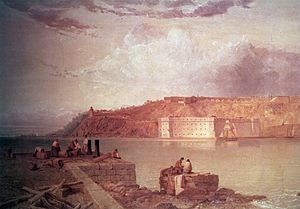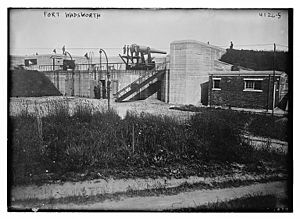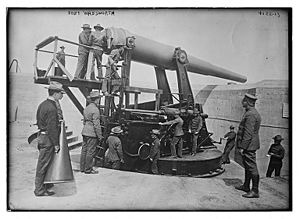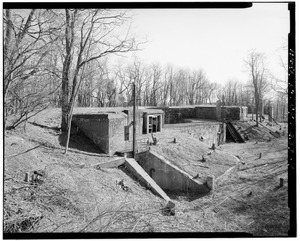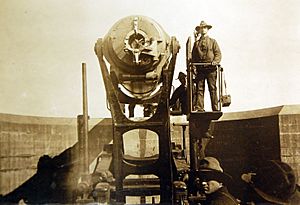Fort Wadsworth facts for kids
Quick facts for kids Fort Wadsworth |
|
|---|---|
| Part of Harbor Defenses of Southern New York | |
| Staten Island, New York | |
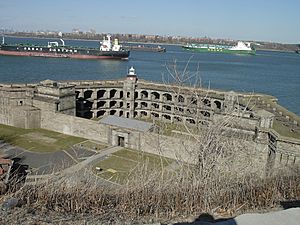
Battery Weed at Fort Wadsworth
|
|
| Coordinates | 40°36′18″N 74°03′24″W / 40.60500°N 74.05667°W |
| Type | Gateway National Recreation Area unit |
| Site information | |
| Controlled by | U.S. Army until 1979 (?) U.S. Navy 1979-1995 National Park Service 1995-present |
| Site history | |
| Built | 1663 (Dutch blockhouse) |
Fort Wadsworth is a really old military base on Staten Island in New York City. It sits right on The Narrows, a narrow waterway that connects the Upper and Lower parts of New York Bay. This spot was perfect for defending New York City.
Before it closed in 1994, Fort Wadsworth was known as the longest continuously used military base in the United States. It has several old forts, like Fort Tompkins and Battery Weed. The fort was named in 1865 after Brigadier General James S. Wadsworth, a brave soldier who died during the American Civil War. Today, Fort Wadsworth is part of the Gateway National Recreation Area and is looked after by the National Park Service.
Contents
A Look Back: Fort Wadsworth's History
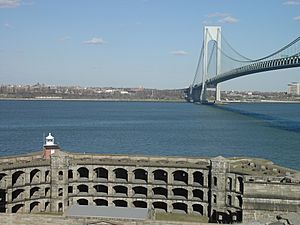
How It All Started
The land where Fort Wadsworth stands was first used for military purposes way back in 1655. A Dutch settler named David Pieterszen de Vries built a small fort, called a blockhouse, on Signal Hill. This is where Fort Tompkins is today.
Another blockhouse was built in 1663. People say that soldiers have been stationed here ever since, making it a very old military site! During the American Revolution, the British took over the area in 1776 and made the fort bigger. It stayed in British hands until the war ended in 1783.
In 1806, New York State took charge. They built four new forts on the site by 1808. These included Fort Richmond (where Battery Weed is now) and Fort Tompkins. These early forts were different from the ones you see today. They were ready for action during the War of 1812.
Forts in the War of 1812
During the War of 1812, New York State made Fort Richmond and its nearby forts even stronger. By 1815, there were reportedly 900 cannons ready in the area! New York City was never attacked during that war. This was probably because of all the forts and cannons protecting the city and its harbor. So, the forts at Wadsworth never had to fire in a real battle.
Building Stronger Forts
By 1835, the forts were getting old and needed repairs. The U.S. government bought them in 1836. In 1847, they started completely rebuilding Fort Richmond and Fort Tompkins. This was part of a big national plan to build new, stronger forts after the burning of Washington, D.C. in the War of 1812.
Some people say that Robert E. Lee helped design the new forts. He was an engineer at a nearby fort in the 1840s. The new Fort Richmond had four levels of cannons facing the sea. This was very unusual! Fort Tompkins was designed to protect the land side, with many places for soldiers to fire muskets. Both forts were almost ready when the American Civil War began in 1861.
The Civil War Years
New York City was not attacked by sea during the American Civil War. So, the forts at Wadsworth didn't see much fighting. But they were important places for gathering soldiers. Fort Richmond was renamed Fort Wadsworth in 1865. This honored General James Wadsworth, who died in the war.
After the war, people realized that old stone forts were not as useful anymore. In the 1870s, new earth-covered batteries were built. These had powerful Rodman guns, which were large cannons. Fort Wadsworth also got a special "disappearing gun." This gun would pop up to fire and then hide again to reload.
Modernizing for Defense (1885–1916)
In 1885, a group called the Endicott Board suggested big changes for U.S. coastal defenses. They wanted new, modern guns. Fort Wadsworth was a big part of this plan. In 1902, the whole fort area was officially named Fort Wadsworth. The old Fort Richmond became Battery Weed, named after another Civil War general.
From 1896 to 1905, many new batteries were built at Fort Wadsworth. These included:
| Name | Number of Guns | Gun Type | Years Used |
|---|---|---|---|
| Ayres | 2 | 12-inch disappearing gun | 1901-1942 |
| Dix | 2 | 12-inch disappearing gun | 1904-1944 |
| Hudson | 2 | 12-inch disappearing gun | 1899-1944 |
| Richmond | 2 | 12-inch disappearing gun | 1899-1942 |
| Barry | 2 | 10-inch disappearing gun | 1897-1918 |
| Upton | 2 | 10-inch disappearing gun | 1897-1942 |
| Duane | 5 | 8-inch disappearing gun | 1896-1915 |
| Mills | 2 | 6-inch disappearing gun | 1900-1943 |
| Barbour | 4 | 6-inch and 4.72-inch quick-firing guns | 1898-1920 |
| Turnbull | 6 | 3-inch pedestal gun | 1903-1944 |
| Bacon | 2 | 3-inch masking parapet gun | 1899-1918 |
| Catlin | 6 | 3-inch pedestal gun | 1903-1942 |
These new guns were much faster and more powerful. Some temporary guns were even bought from the United Kingdom during the Spanish–American War in 1898. In 1910, the fort fired a special 21-gun salute for former President Theodore Roosevelt when he returned from a trip.
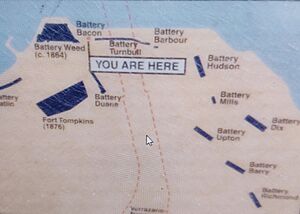
World War I and Beyond
When the United States entered World War I, Fort Wadsworth was very important. It was the largest fort protecting New York City. Some batteries had to be ready to fire all the time. Many guns were moved from forts to be used as railway artillery on the Western Front in Europe. Fort Wadsworth had some of its guns replaced by others from less threatened forts.
After World War I, many older guns were removed. By 1924, Fort Wadsworth became a base for infantry soldiers. Its big coastal guns were mostly kept in "caretaker status," meaning only a few soldiers maintained them. Newer, longer-range guns at other forts meant Fort Wadsworth was no longer the main defense.
World War II and the Cold War
Fort Wadsworth was an important place for gathering soldiers during World War II. However, it didn't get many new weapons. The main defenses for New York City were at other forts with even bigger guns. Fort Wadsworth's heavy guns were slowly taken apart during the war.
After World War II, all U.S. coastal artillery guns were removed. From 1948 to 1960, Fort Wadsworth was the headquarters for air defense units protecting New York City. It was also a headquarters for Nike missiles from 1952 to 1964, but no missiles were actually kept at the fort. Later, it became home to the U.S. Army Chaplain school. It also had a museum inside Fort Tompkins.
In 1979, the base was given to the United States Navy. They used it as the main office for Naval Station New York. But in 1995, the Navy left. The land was then given to the National Park Service. It became part of the Gateway National Recreation Area.
Since 1996, the United States Coast Guard has used some of the buildings at Fort Wadsworth. They moved their New York operations here after their base on Governors Island closed.
Fort Wadsworth Today
As of 2025, several groups use the buildings at Fort Wadsworth. The United States Coast Guard has its Sector New York and a special team there. The 353d Civil Affairs Command, a United States Army Reserve unit, also uses some buildings. The National Park Service has offices and educational facilities. The United States Park Police also have operations here.
What to See and Do Now
You can still see many historic buildings at Fort Wadsworth. These include Battery Weed, right on the harbor, and Fort Tompkins, which sits on the hill above. Both were built in the mid-1800s. You can visit them on guided tours.
There are also smaller old gun batteries from the early 1900s. You can find an overlook with amazing views of the Upper Bay, Brooklyn, and Manhattan. There's a memorial to Father Vincent R. Capodanno, a Navy chaplain from Staten Island. He was a hero who received the Medal of Honor after he died serving in Vietnam.
The National Park Service has a visitors' center at the fort. They offer tours led by park rangers. Parts of the fort, like Battery Weed and Fort Tompkins, are listed on the National Register of Historic Places. The entire Fort Wadsworth complex was added to the National Register in 2022.
Fun Events at the Fort
Fort Wadsworth is a starting point for two big events in New York City:
- The New York City Marathon: This famous running race (about 26 miles long) starts at Fort Wadsworth every year.
- The Five Boro Bike Tour: This fun bike ride starts in Lower Manhattan and ends with a festival at Fort Wadsworth.
The Fort Wadsworth Neighborhood
The name "Fort Wadsworth" is also sometimes used for the neighborhood around the old fort. This area is south of Rosebank, west of Shore Acres, and north of South Beach. This neighborhood once had a train station called Fort Wadsworth station on the Staten Island Railway. But the train service stopped in 1953.
 |
Rosebank & Clifton | Shore Acres & Upper New York Bay | Bay Ridge & Fort Hamilton |  |
| Rosebank | The Narrows | |||
| Grasmere | Arrochar | South Beach & Lower New York Bay |
See also
- Fort Wadsworth station of the Staten Island Railway
- Fort Wadsworth Light
- Seacoast defense in the United States
- United States Army Coast Artillery Corps





